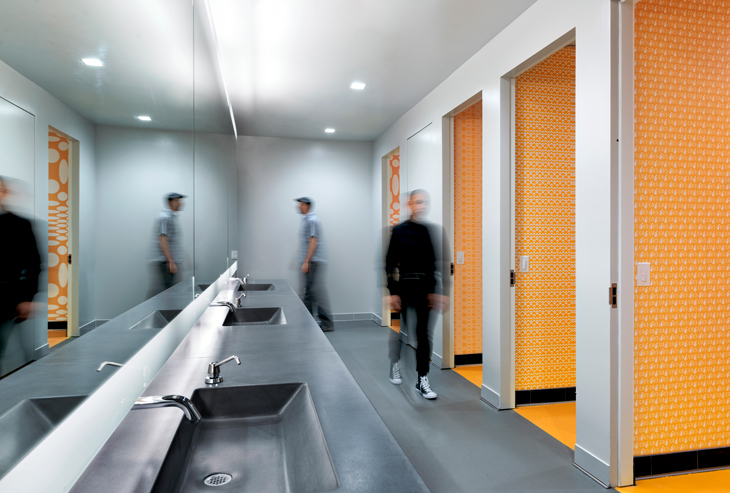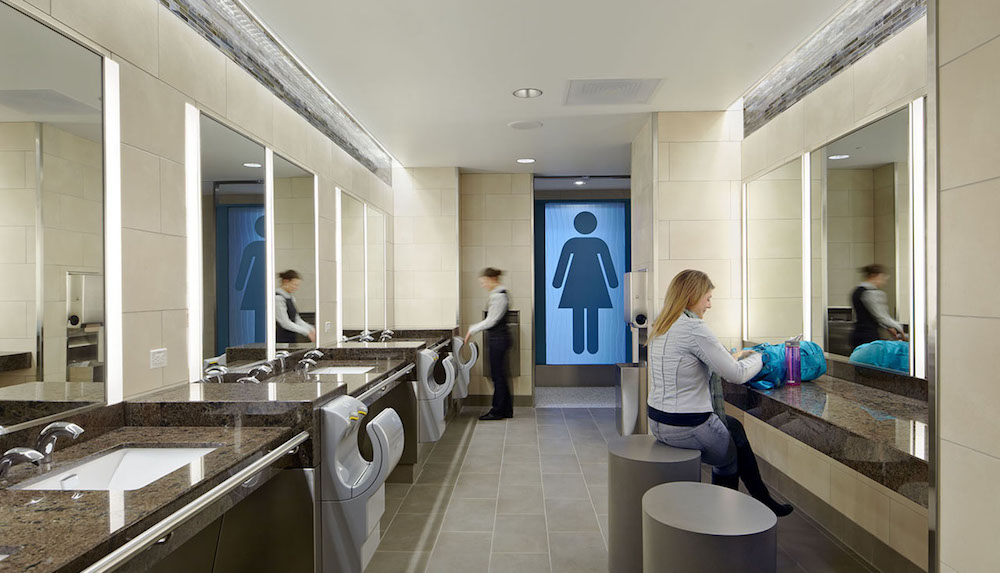When I started my career, I never thought I would spend so much time talking about corporate bathrooms. But the truth is people feel passionately about them. They might be the most underappreciated and most necessary spaces in the workplace. Everyone has to go there (no giggles please), and the experience usually falls somewhere between bland and horrifying. It’s no wonder that so many people I talk to on projects—from executive leaders to employees—bring up bathrooms as one of their top complaints.
What do people dislike about bathrooms the most? Lack of privacy, poor ventilation, bad acoustics, lack of convenient features (hooks, shelves, full length mirrors), and myriad inconveniences, like the need to protect your newly cleansed hands from the germ infested door handle. Part of the reason companies don’t have better bathrooms is that they usually have to pay to upgrade them and may not have the authority to do so. Bathroom design and budgets typically fall under the purviews of landlords and developers, and these parties don’t always view upgraded bathrooms as a worthwhile investment. They are. Whether the responsibility lands on the landlord or tenant, good bathrooms are worth the investment. There is no question they are critical to enhancing each employee’s overall experience of the workplace.
I recently interviewed a very senior executive about his company’s headquarters project, and I asked him what, in his opinion, was the number one thing to get right in the new space. I expected him to respond with a big statement about how the overall form and function should support the company’s business strategy. Instead, he looked at me with conviction and said, “Better bathrooms. They are appalling today, and they are extremely important, as important as having great amenities like a gym.” This took me by surprise, but since then I’ve heard similar comments from numerous other people across a whole range of companies and industries. Many of our current clients have taken note and are now working with us on beautiful and functional bathrooms in their newest projects—from Capital Group in Los Angeles to Symantec in Mountain View, Calif. to Paul Hastings in New York.
 Privacy and style have become hallmarks of bathroom design on some corporate campuses. Pictured above: the men’s room at Symantec in Mountain View, Calif. Image: Gensler.
Privacy and style have become hallmarks of bathroom design on some corporate campuses. Pictured above: the men’s room at Symantec in Mountain View, Calif. Image: Gensler.
This rallying cry to improve corporate bathrooms strikes me as a relatively new phenomenon. The cause? Corporate clients now regularly reference the beautiful, high impact bathrooms they experience in restaurants, hotels, and even airports. The prevalence of nice bathrooms in public amenity spaces has raised the baseline for bathroom design; some clients even talk about the luxurious bathrooms they’ve experienced in private homes. As a result, corporate executives realize workplace bathrooms haven’t kept pace. In other building types, bathrooms are sanctuaries; in too many workplaces they more closely resemble fetid back alleys.
One complaint I’ve heard a lot recently concerns the lack of privacy in bathrooms, and there’s no question this is a U.S. centric issue. A financial services client who moved to New York from London once passionately asked me, “What’s up with the cowboy stalls in this country? How can the doors not go to the ground? It’s uncivilized! Unthinkable!” I actually think he’s right. You would never see that in London or other Western European cities. The good news is that many new developers are beginning to invest in great bathrooms because doing so will help attract prospective tenants. And there are some great new products like Privada, which have handsomely designed stall walls and doors that go to the ground (or slightly above to accommodate mopping). The Privada system also has no gaps around the door (another common complaint), takes no more space than a conventional stall, and includes other features like clear indicators as to whether they are in use or available.
While privacy is one issue in bathrooms, another critical one these days is inclusiveness. The expectation now is that everyone, regardless of gender identity, needs easy access to a restroom they feel comfortable using. Gender neutral or unisex bathrooms are becoming far more common in public buildings (schools, airports, etc.) and workplaces. Select cities, including Philadelphia, have considered making the provision of gender neutral bathrooms a requirement. Even without an official mandate, many companies are adding these kinds of restrooms because having them aligns with their commitment to inclusiveness and diversity.
Companies looking for a new space must take time to check out the bathrooms, because bathrooms matter. And if you are in a position to renovate or design a new bathroom at your workspace, you should view them as important spaces that employees, clients and visitors care deeply about. Create bathrooms that are as beautiful, functional and appealing as the rest of the workplace—your employees will notice.
About the Author: Johnathan Sandler is a Principal in our Consulting Group and a Global Leader of the Media Practice. He works closely with leaders and employees on projects that transform their work environments and advance their work practices. Contact him at johnathan_sandler@gensler.com.
More from Author
Gensler | Oct 21, 2024
3 surprises impacting the return to the office
This blog series exploring Gensler's Workplace Survey shows the top three surprises uncovered in the return to the office.
Gensler | Jun 26, 2024
5 ways ESG can influence design and create opportunities
Gensler sustainability leaders Stacey Olson, Anthony Brower, and Audrey Handelman share five ways they're rethinking designing for ESG, using a science-based approach that can impact the ESG value chain.
Gensler | May 20, 2024
10 spaces that are no longer optional to create a great workplace
Amenities are no longer optional. The new role of the office is not only a place to get work done, but to provide a mix of work experiences for employees.
Gensler | Apr 15, 2024
3 ways the most innovative companies work differently
Gensler’s pre-pandemic workplace research reinforced that great workplace design drives creativity and innovation. Using six performance indicators, we're able to view workers’ perceptions of the quality of innovation, creativity, and leadership in an employee’s organization.
Gensler | Mar 13, 2024
Trends to watch shaping the future of ESG
Gensler’s Climate Action & Sustainability Services Leaders Anthony Brower, Juliette Morgan, and Kirsten Ritchie discuss trends shaping the future of environmental, social, and governance (ESG).
Gensler | Feb 15, 2024
5 things developers should know about mass timber
Gensler's Erik Barth, architect and regional design resilience leader, shares considerations for developers when looking at mass timber solutions.
Gensler | Jan 15, 2024
How to keep airports functional during construction
Gensler's aviation experts share new ideas about how to make the airport construction process better moving forward.
Gensler | Dec 18, 2023
The impacts of affordability, remote work, and personal safety on urban life
Data from Gensler's City Pulse Survey shows that although people are satisfied with their city's experience, it may not be enough.
Gensler | Nov 16, 2023
How inclusive design supports resilience and climate preparedness
Gail Napell, AIA, LEED AP BD+C, shares five tips and examples of inclusive design across a variety of building sectors.
Gensler | Oct 16, 2023
The impact of office-to-residential conversion on downtown areas
Gensler's Duanne Render looks at the incentives that could bring more office-to-residential conversions to life.
















